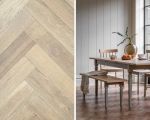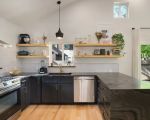
How to Incorporate Vintage Elements into Your Home Remodel
Have you ever walked into a home and felt the weight of its history? Vintage elements bring a unique charm and warmth that modern furnishings just can’t replicate. When remodeling your home, incorporating vintage pieces or styles can give it character, making it stand out in a world of cookie-cutter designs. Let me walk you through how I brought vintage elements into my home remodel, transforming it into a blend of old-world charm and contemporary comfort.
1. Embrace the Power of Vintage Furniture
One of the easiest ways to infuse vintage elements into your remodel is by incorporating antique or retro furniture. Think of that gorgeous mid-century modern armchair, or a vintage wooden dining table with a story to tell. When I started my remodel, I decided to incorporate furniture that had a bit of history attached to it. Not only did this give my space a unique touch, but each piece also added a sense of timelessness. My vintage sofa, with its retro pattern and soft fabric, immediately became a conversation piece. It's perfect for creating a focal point in a room while adding texture and personality.
If you're unsure where to find such pieces, I recommend checking out local flea markets, estate sales, or online marketplaces like Craigslist or Etsy. Sometimes, you'll be surprised at the treasure you can uncover in the most unexpected places!
2. Add a Touch of Vintage Lighting
Lighting plays a crucial role in setting the ambiance of a space. While modern lighting fixtures are sleek and stylish, vintage lighting can create a warm and inviting atmosphere. I decided to install a vintage chandelier in my dining room. The delicate brass detailing and antique glass bulbs provide an elegant, soft glow that no contemporary light fixture could replicate. It adds an element of nostalgia, transporting me to a different era every time I walk under it.
Consider mixing vintage lighting with modern fixtures to create contrast. A vintage table lamp paired with a minimalist desk can bring warmth to a cold, industrial space. Don’t forget about the style of lightbulbs either—Edison bulbs, with their exposed filament and vintage feel, are a great option for that authentic retro touch.
3. Incorporate Vintage Textiles and Patterns
Textiles, such as throw pillows, curtains, and rugs, can significantly influence a room's aesthetic. Vintage fabrics and patterns can easily be integrated into any home remodel. For my living room, I found a vintage Persian rug that tied the room’s entire design together. Its intricate patterns and bold colors brought an element of sophistication and warmth that I hadn't achieved with modern rugs.
If you don’t have access to a vintage rug or fabric, consider using fabric wallpaper with retro patterns or florals. Additionally, incorporating vintage throws or pillows with bold prints can quickly update your space without overwhelming it. It's all about balancing modern touches with these nostalgic textiles.
4. Vintage Kitchen Details for a Timeless Appeal
The kitchen is often the heart of the home, and incorporating vintage elements here can create a space that feels both functional and full of character. When remodeling my kitchen, I chose retro-style appliances that combined both modern efficiency and vintage charm. The mint green fridge I found at an antique store became an unexpected statement piece. It’s not only functional but also a lovely nod to a bygone era.
Additionally, vintage-style subway tiles or retro kitchenware, such as enamel cookware or old-fashioned glass jars, can be used to complement your remodel. Incorporating these small but impactful touches can give your kitchen a cozy, lived-in feel without sacrificing practicality.
5. Revitalize Your Walls with Vintage Art and Mirrors
Art can define the mood of a room, and vintage artwork can lend your home a timeless appeal. I decided to hang a few vintage paintings from local thrift stores in my hallway. Their intricate frames and rich colors gave the space an elegant, refined touch. Vintage mirrors are also an excellent addition to any room, offering both functionality and style. A gilded antique mirror placed above my fireplace created a sense of grandeur in the living room, making the space feel more expansive and sophisticated.
When shopping for vintage art, consider works from different periods, like Victorian landscapes or retro 60s pop art. Mixing and matching styles will create a curated, one-of-a-kind collection that speaks to your personal style.
6. Reuse and Upcycle Vintage Materials
Sometimes, the best way to bring vintage elements into your remodel is through repurposing old materials. During my home renovation, I had a lot of old wood salvaged from a demolished shed. I used the reclaimed wood to create a stunning accent wall in my living room. The rough-hewn wood added an earthy, rustic vibe, giving the room a sense of history and depth.
If you’re handy with tools, you can also repurpose vintage doors, windows, or even old flooring to create one-of-a-kind furniture pieces or architectural details. Not only is this an eco-friendly way to incorporate vintage elements, but it also gives your home a story to tell.
7. Creating a Vintage-Inspired Color Palette
The colors you choose for your walls, furniture, and accessories will play a huge role in how vintage elements stand out in your remodel. I opted for a muted color palette of dusty rose, olive green, and mustard yellow—hues that evoke a sense of retro nostalgia. These colors, paired with neutral shades, allowed my vintage furniture and accessories to shine without overwhelming the space.
When selecting your palette, think about the era you're inspired by. For example, if you love mid-century modern design, you might incorporate vibrant oranges, teals, and browns. For a more Victorian-inspired room, rich, deep colors like burgundy or forest green will work wonders. The key is to select colors that complement your vintage finds, rather than clash with them.
8. Blend Old and New for a Harmonious Look
One of the challenges when incorporating vintage elements into your home remodel is ensuring that the old and new blend seamlessly. I found that the key is balance. While I introduced vintage elements like furniture, lighting, and textiles, I also kept some modern elements like sleek furniture or contemporary art to prevent the space from feeling like a museum.
For instance, pairing an antique writing desk with a modern ergonomic chair or combining a retro sideboard with a minimalist TV stand creates an interesting contrast while keeping the overall design cohesive. Blending the old with the new allows you to keep the charm of vintage items while still maintaining a fresh and contemporary feel.
By incorporating vintage elements thoughtfully and creatively, you can create a home that feels both timeless and unique. The key is finding the right balance that reflects your personality and the story you want to tell through your space. Whether you’re mixing mid-century modern with contemporary touches or incorporating vintage lighting and textiles, these additions will make your remodel stand out in a world of mass-produced designs.








